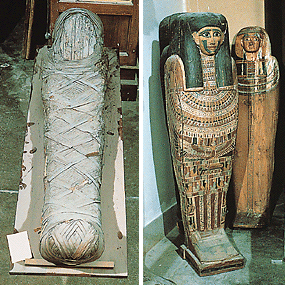October 20-26, 2011, Current Events Lesson Plan
Current Event:
British scientists recently announced that they rediscovered the process used by ancient Egyptians to produce mummies more than 3,000 years ago. They preserved the body of British taxi driver Alan Billis, who volunteered for the project after learning that he was dying of lung cancer.
Objectives:
The Behind the Headlines news story and related World Book articles will provide students with an overview of the ancient process of mummification and its historical context juxtaposed next to a modern mummification experiment.

Egyptian mummies were wound tightly with linen and then laid out in coffins. In some periods of Egyptian history, the coffins were painted. The Field Museum, Chicago.
People and Places:
Vocabulary Terms:
- afterlife
- dehydrate
- embalming
- formaldehyde
- mummify
- pharaoh
- preserve
- tomb
Discussion Topics:
1. The ancient Egyptians mummified their dead to preserve their bodies because they believed they were needed in the afterlife. Discuss the mummification technique and what made the process work.
2. British taxi driver Alan Billis volunteered to be mummified after learning that he was dying of lung cancer. Why do you think he made this decision?
3. The ancient Egyptians made mummies, but there are also examples of mummies preserved through natural means. Discuss the differences between the Egyptian mummification method and the natural ways the “Iceman” was preserved in the Alps and bog bodies were protected in Denmark and other countries in northern Europe.
4. Use World Book’s timeline feature to make a timeline of the pharaohs of ancient Egypt from 3500 B.C., when the Egyptians were experimenting with mummification, to about A.D. 300, when mummification was replaced by simple burials.
5. Find out if there is a mummy exhibit at a museum near you or watch a video of the largest mummy exhibit, Mummies of the World, on YouTube.


